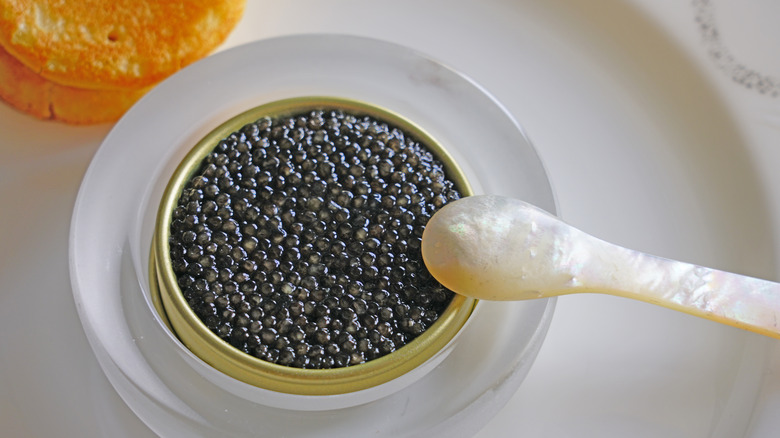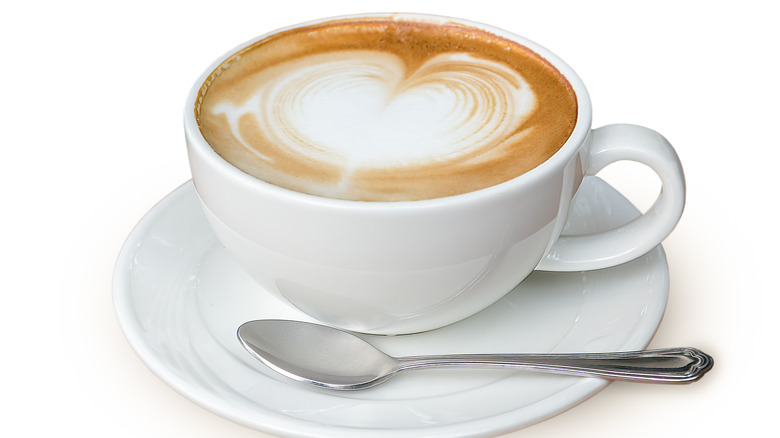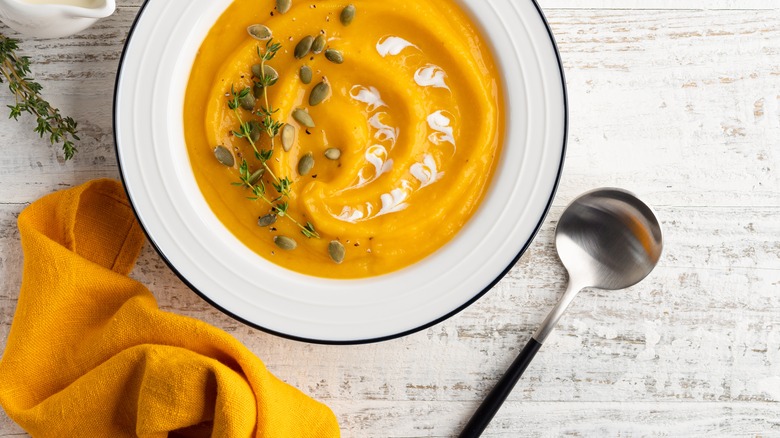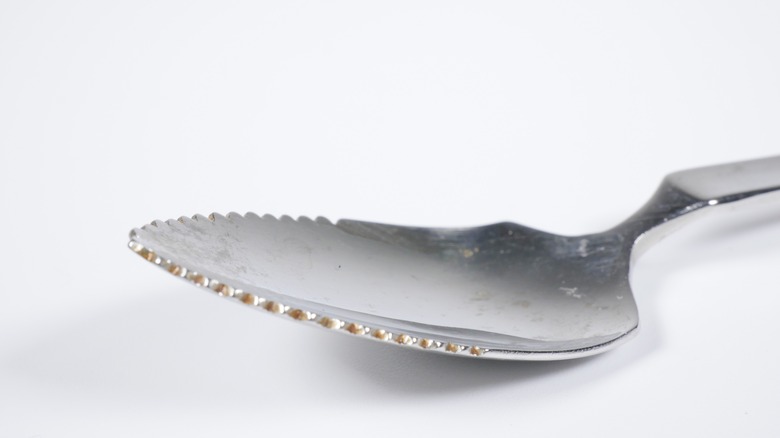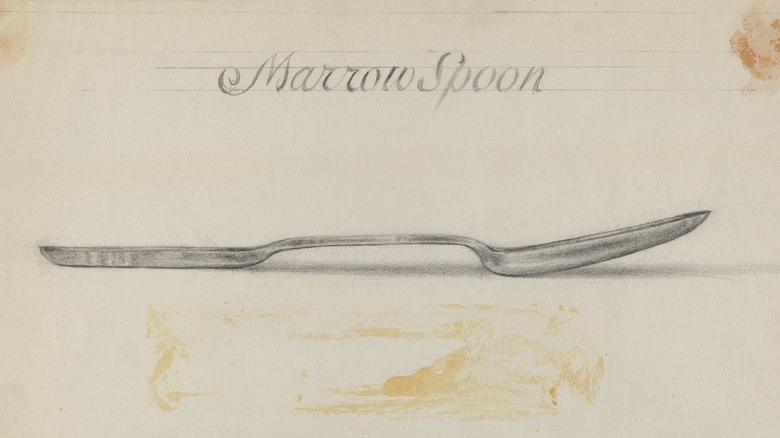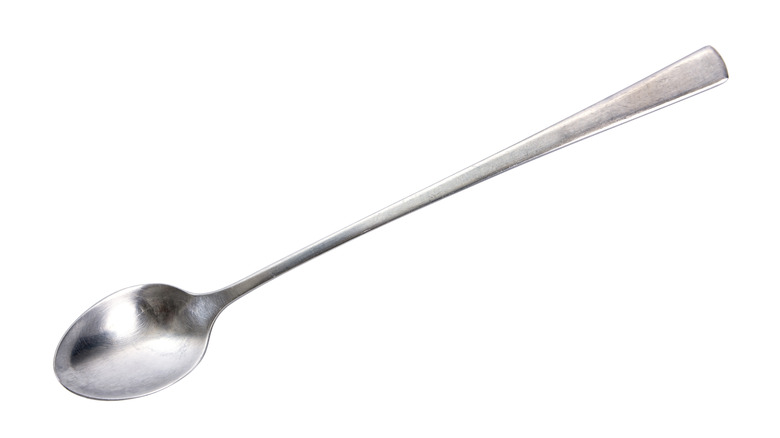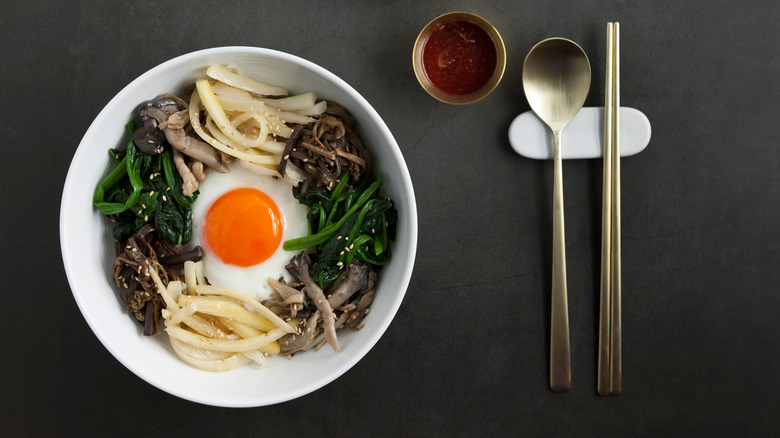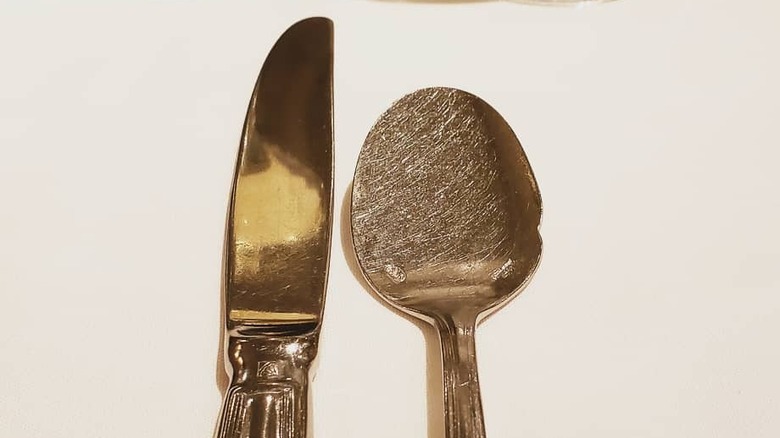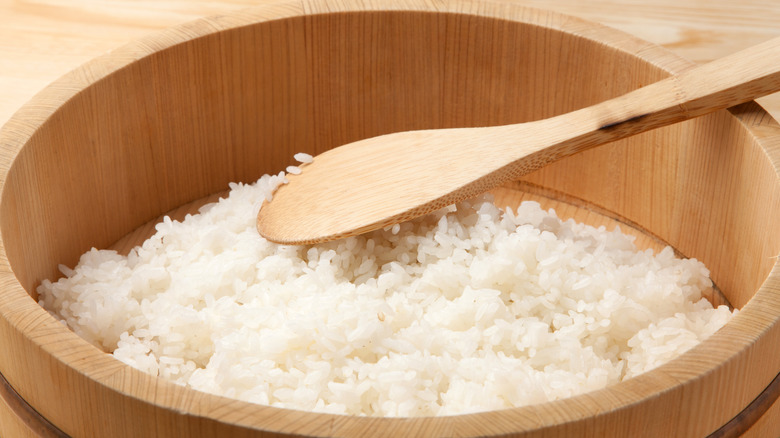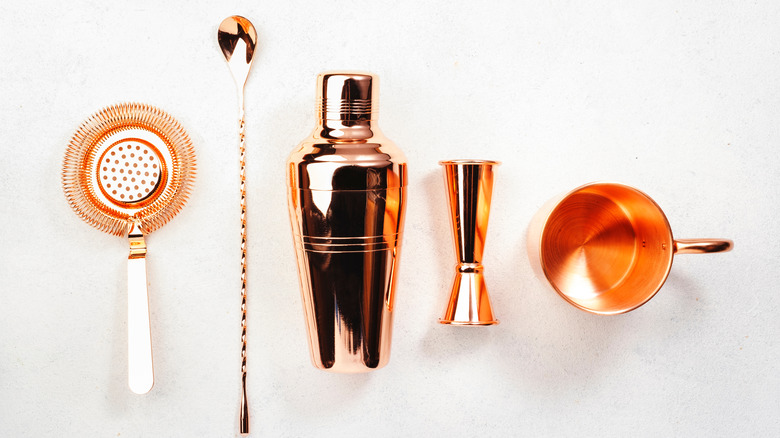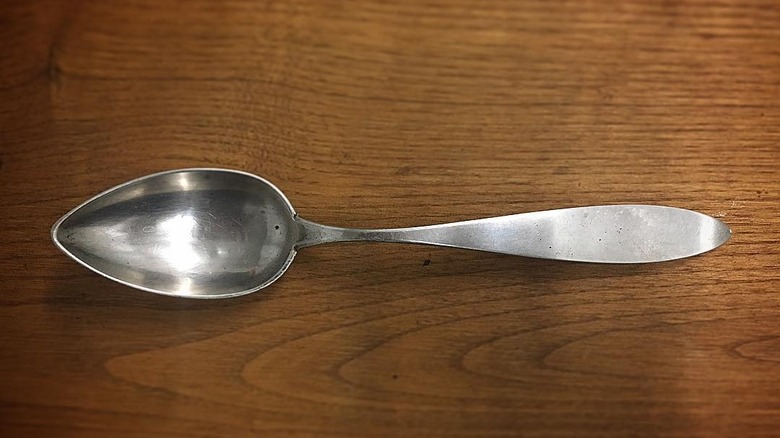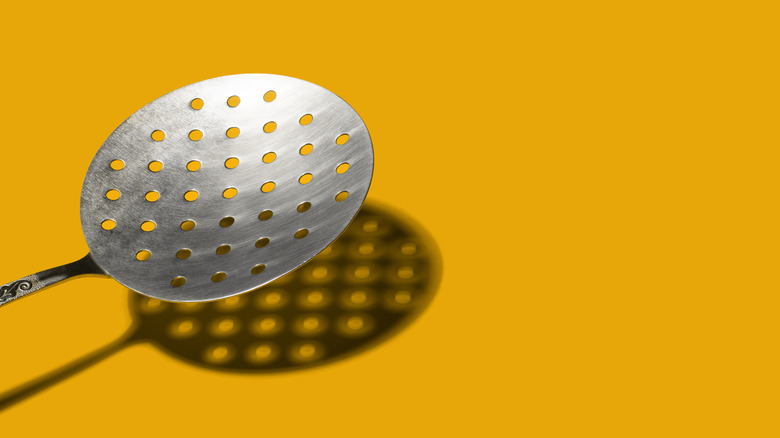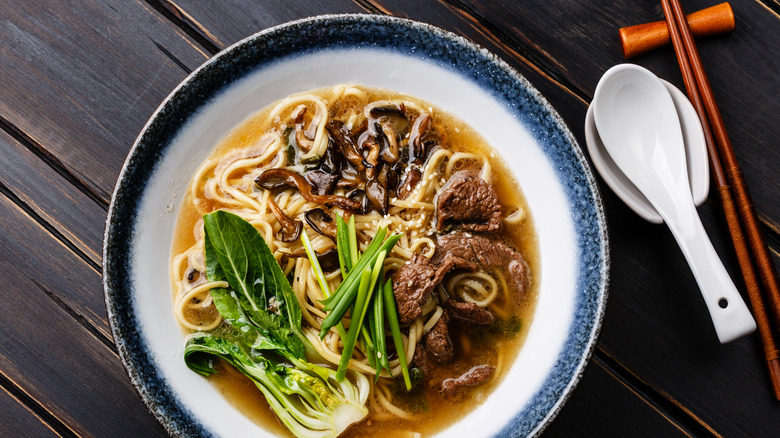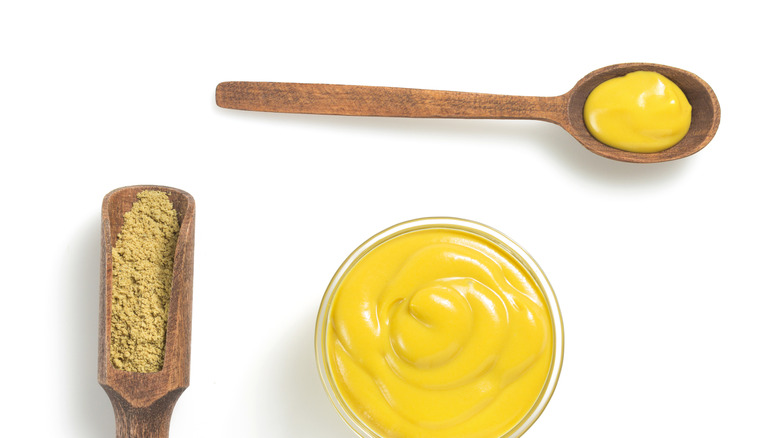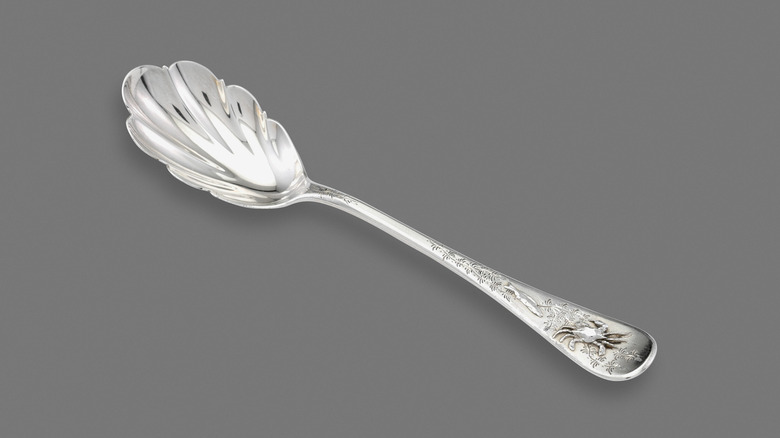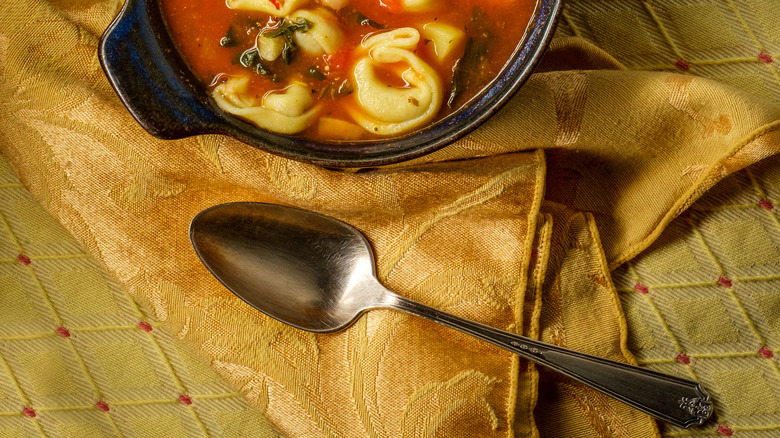17 Types Of Spoons, Explained
While the origin of the spoon is not truly known, we do know that spoons have been around for centuries, and the first spoon-like utensils were used by the Egyptian pharaohs (via Eating Utensils). Since then, spoons have undergone many transformations and become an important instrument worldwide for various uses. The spoons you are probably accustomed to eating with may seem generic and perhaps even underwhelming, but the spoons' history is creamy and rich.
Made from bones, brass, stone, wood, or various other metals, spoons have always been a way for artists to express their craft and as a vehicle for displaying wealth and status. Today, spoons are useful for measuring, stirring, serving, and so much more. Their design, shape, and length can indicate a specific use they were designed for and teach users about the complex world of spoons. You may even have a favorite spoon chosen for its long, elegant handle or maybe because of its deep, generous bowl. No matter the reason, spoons bring us pleasure and can be a magnificent way to elevate any eating experience.
Deciding which types of spoon to add to your collection of kitchen utensils will depend on the foods you tend to eat and your cooking style. From caviar and demitasse spoons to the very common tablespoon, there's a great variety of spoons to explore.
Caviar spoon
When it comes to elegance and luxury, caviar is a staple in fine dining. It should be no surprise that a spoon is explicitly designed to serve caviar. A caviar's delicate texture and flavor can react with other elements, such as metal, thus changing the flavor and ruining the taste. Therefore, silver spoons are a big no-no when eating and serving caviar. Rather, Petrossian Caviar suggests using a mother-of-pearl spoon. This option will preserve your caviar's pure, bright flavor and add a shimmering glow to your caviar tasting.
In the past, caviar spoons were made from other nonreactive materials such as gold and animal horns. Now, mother-of-pearl spoons are the go-to caviar serving utensil. Considering caviar's place as one of the world's most prized and rarest food delicacies, investing in a caviar spoon is reasonable for any caviar lover so you can gingerly place caviar on top of your next crostini.
Demitasse spoon
The demitasse spoon is one you have probably seen many times and thus taken for granted. In the world of table settings and fine dining, it plays a very important role. Inspired by Chinese teaspoons and developed in France in the mid-19th century, demitasse spoons are small, ornately decorated spoons no longer than four inches.
According to The Coffee Brewers, before the espresso was invented, the word demitasse referred to a small cup of strong coffee regularly consumed after dinner. Demitasse spoons were then used to stir in sugar or cream.
Today, demitasse spoons are still used in formal dining settings to scoop sugar for espresso. At antique stores, you may find demitasse spoons created for specific events, families, and celebrations, as well as those with matching dishes or other cutlery. Like other metal utensils, these spoons became a way for metal workers to show off their craft and celebrate elaborate decorations. Next time you have a strong espresso or scoop sugar into your tea, think about the long history and care that went into creating the demitasse spoon.
Soup spoon
The soup spoon is a beloved classic, perfect for scooping up your favorite soup. Larger than most spoons, it has a straight handle and an enlarged basin designed to hold soup and other soft foods. A standard soup spoon is about six inches long and has an almost perfectly circular deep scoop which creates a little bowl for your soup to nestle into as you wait for it to cool.
The soup spoon has much more to offer than first meets the eye. It is sturdy and reliable, and when you find a soup spoon that you love, it may even have the profound ability to make your soup taste better. According to The New York Times, Arne Jacobson, a renowned Danish architect, was smitten by the versatility and splendor of spoons and collaborated with hospitality companies to design cutlery that contributed to the experience of eating. Jacobson loved soup. He would eat it for lunch most days, and his love for soup can be tasted in the intelligent, comfortable design of his soup spoon. If you also have a hankering for soup, try making this matzo-ball posole and take a moment to celebrate how perfectly your spoon cradles the matzo balls and elevates the entire experience.
Grapefruit spoon
Grapefruit spoons are funny-looking things! With teeth around the edges that are not conducive to soup slurping, you might wonder why you want one of these. Well, the answer is actually fairly straightforward — for your grapefruit.
As its name suggests, grapefruit spoons are designed specifically to scoop out grapefruit segments. If you have ever tried to eat half a grapefruit with a standard spoon, you know that it can be a messy experience. Whether you like eating grapefruit with some sugar or prefer another preparation, such as broiled grapefruit, grapefruit spoons enable you to scoop out individual sections of fruit without having to peel, slice, or gouge it out.
While grapefruit spoons are not exactly necessary, these mini spoon-knife hybrids certainly are very fun. As per Delighted Cooking, grapefruit spoons are versatile and can be used to eat other citrus fruits like oranges or pomelos and scoop squash and other fruits like melon.
Marrow spoon
First designed in the late 1600s (via Victoria and Albert Museum), marrow spoons aid in the removal and eating of marrow, the jelly-like inside of bones. Marrow is valued for its fattiness and savory richness but is understandably challenging to remove because it is surrounded by bone. If you tried to scoop marrow using a regular table spoon, you would literally hit the bone's walls. The marrow spoon, with its long handle and narrow basin, is perfect for scooping out the inside of a bone.
In the 17th century, eating marrow became more common in Europe and led to the creation of the marrow spoon as we know it today. The Victoria and Albert Museum also explains that around this time, table manners were going through a period of refinement. Combining this with the rise in popularity of marrow, the marrow spoon quickly became an indication of class.
Ice tea spoon
Ice tea spoons are not only practical, but they are also undeniably fun to use. Ice tea spoons are whimsical and delightful, with a very long handle that can reach clear to the bottom of a glass without drowning the handle. Usually ranging in length from seven to 10 inches, ice tea spoons are used for precisely what their name implies. They are a great way to stir lemon, sugar, or other flavorings into a glass of your favorite iced tea. Ice tea spoons are also a great option to use with ice cream sundaes and other desserts and make any treat more enjoyable.
Ice tea spoons are most commonly used in casual settings, and as per Restaurant Supply, they are not usually included in fine dining table sets. That doesn't mean they don't have a place at your table! Ice tea spoons are a summertime staple, and their long handles and small scoop make eating anything that much more enjoyable, whether it is ice tea, a soda float, or a sundae.
Sujeo
With a long, slender spoon accompanied by equally sleek metal chopsticks, sujeo refers to an iconic Korean mealtime kit. Soup is a staple in Korean cuisine and it is commonly believed that any meal is not complete without jiage (stew). This love for stew, and therefore spoons, also sets Koreans apart from other Asian countries, like Japan and China, where soup is usually sipped from the bowl.
At a Korean table, it is common to see a complete sujeo set, with the spoon to the right of the rice and the chopsticks to the right of the spoon. As with other metal utensils, sujeo used to indicate status depending on how they were embellished or engraved. Today, families may have sets they use for special occasions, but more commonly, sujeo are made from stainless steel for everyday use.
Sauce spoon
Have you ever had a dish with a sauce so delicious that all you want to do is to eat it by the spoonful? Well, if you haven't experienced this, you should go and make some sauce because a great sauce can make any dish better. The French have always had a deep devotion to sauces, so much so that they created a whole new type of spoon just to celebrate scooping up the sauce.
A sauce spoon, or saucier spoon, is a delicate spoon that, to a common observer, may look just like a regular dessert spoon. Do not be deceived. As per Bauscher Hepp, a sauce spoon has a slightly flat basin and a distinctive notch on one side. This notch is not a defect and is, in fact, a very intentional design feature. The little indent serves as an escape route for any excess fat, enabling it to drain off before indulging in a spoonful of deliciousness.
Created in the Parisian restaurant Lasserre in the 1950s, sauce spoons are now a table setting stable, finding a place in between the dinner plate and knife. It is most frequently used with fish or meat courses and can be found at high-end French restaurants.
Panja spoon
Many cultures around the world scoop rice with various instruments, and in India, it is common to use a panja. The panja spoon has a very wide, flat basin which provides a large surface area to scoop rice in the perfect portion size (via Ramson Industries). Panja usually have grooves running vertically up the scoop and sometimes a hole at the end of the handle to enable hanging storage. Traditionally used to serve rice, panja can also be used to serve other dishes, such as casseroles.
If you want to use your panja with a rice dish, try making briyani. Make sure to scoop your rice gently and thoroughly with your panja. This will help the rice grains separate instead of sticking together, all while delicately mixing in your seasonings.
Shamoji
The first rule of using a shamoji is to rinse it with water before you use it. This way, the natural starch of the rice will not stick to the shamoji and will keep it clean and smooth throughout your meal.
But what exactly is a shamoji, and how is it different from other rice scoops? A shamoji is a Japanese rice paddle used in all stages of the rice-making process. According to Oishii, shamoji are made of plastic or wood, with intentionally soft edges to minimize the amount of mashed rice. This also ensures that your rice cooker pot will remain unscathed if you choose that vessel to cook your rice.
Shamojis have a long history directly tied to Japanese culture and rice. Rice, the staple grain in Japanese cuisine, must be treated with the utmost respect. This means that cooking rice in a way that celebrates its flavors and qualities is essential, and one way to do this is with a shamoji. It is believed that lightly fluffing rice once it is done cooking allows each grain to release excess steam and obtain the desired shine and bite. Shamojis are also used for serving rice and clearing the pot once a meal is finished.
Bar spoon
According to Advanced Mixology, the delicate flavor of some spirits, such as brandy or rum, can change when they are shaken. Therefore, it is best to stir classic cocktails like the Manhattan or Negroni to ensure that the full flavor of the alcohol can be celebrated appropriately.
When making a stirred drink, using a bar spoon is the best choice. These spoons are a bit longer than iced tea spoons, measuring 12 to 15 inches in length, and have a distinct corkscrew handle that adds a bit of flair. Advanced Mixology explains that there are many variations of the bar spoon, such as the European version with a disk at the top of the handle and the Japanese bar spoon that replaces this disk with a gentle teardrop shape.
Bar spoons are not only used for mixing drinks. They are important for muddling other drink components, like herbs and spices, and are also used for measuring ingredients or curling garnishes.
Quenelle spoon
A quenelle is an ovular, pointed dollop of cream, mousse, or other soft food that often delicately decorates fine dining plates (via Foodsguy). The perfect quenelle is a piece of art, and it can take chefs years to achieve this immaculate, seamless shape. Quenelle spoons often come in pairs because a classic quenelle is made by scooping two spoons against each other lengthwise. This method achieves the signature quenelle look that is so appealing and beautiful.
The Foodsguy explains that a quenelle spoon is pointed at the end to help achieve the signature point of a quenelle. They also have deep basins to ensure that the quenelle has enough body and holds its signature round shape. While they do not look extraordinary, quenelle spoons are essential fine-dining instruments and help make any dish look more extravagant and refined.
Slotted spoon
This is a spoon you may have used a dozen times and just take for granted. Slotted spoons are in almost every home kitchen today, but their origin is a little bit less well-known.
According to HomeQuicks, slotted spoons were first used in the 1700s for absinthe. An extremely alcoholic drink, absinthe was long believed to have hallucinogenic properties, and it is commonly poured over sugar cubes prior to drinking. Created to hold sugar cubes for absinthe, slotted spoons have since traversed the world and found a way into many home kitchens.
Today, slotted spoons can be used for any variety of things, from scooping up wontons to taking your boiled eggs out of the water bath. No matter the use, the convenient shape of the spoon, and the slats that allow water to pass through, are undeniably useful for straining or when you are just trying to get the best morsel of food.
Ramen spoon
The first step to eating ramen is sipping the broth, according to Ramen Hero. This is achieved by using a ramen spoon, or chirirenge. Once you taste your broth, sense the temperature, and become sufficiently hungry, it is time to dive into your bowl of noodles.
Ramen Hero also explains that chirirenge translates to "fallen lotus petal" in Japanese, referring to the spoon's flat, deep bowl-like shape and thick, grooved handle. The handle has a small crook at its end, which can let the spoon rest in your ramen bowl without disappearing into the broth. Throughout your meal, you can use the spoon as a small bowl, lifting your noodles into the spoon and filling the basin with a bit of broth to create a delicious mouthful. You can also use the spoon to scoop up some of the delicious ramen toppings or as a place to let your noodles cool before you dig in.
To enable maximum ramen-eating mobility, hold your chopsticks in your right hand and the ramen spoon in the left. This method allows you to sip on broth intermittently while eating and catch any falling noodles or toppings that tumble out of your chopstick's grasp. Ramen is meant to be eaten quickly, so hurry up and embrace your ramen spoon to consume ramen at peak efficiency.
Mustard spoon
Once the mustard pot was popularized in Europe in the 1760s, mustard spoons became their commonplace companion (via Antique Silver Spoons). With a long oval basin designed to scoop mustard from mustard pots, mustard spoons today are most commonly saved as antiques and collector's items.
Only a couple of inches in length, the mustard spoon is an accessory to the table and can be used to serve any variety of mustard. Much like other serving spoons, mustard spoons can sport ornate metal work that sometimes even matches the mustard pot, and their styles vary from England to Ireland to Scotland.
Sugar spoon
A spoonful of sugar helps just about everything, and what better to scoop sugar than with a sugar spoon? Usually found in formal tea or coffee settings, sugar spoons are specifically designed to hold a generous scoop of sugar. They often come paired with a matching sugar pot that holds white crystal sugar, and according to Delighted Cooking, they are weighted specifically to ease in the sprinkling of sugar.
The most common shape of a sugar spoon resembles a sea shell, so they are often referred to as sugar shell spoons. Sugar shell spoons have fluted edges that help break apart the sugar in the pot, separating the granules and ensuring that it sprinkles evenly. This also gives you more control over the amount of sugar you are adding to your drink because each additional grain will add another drop of sweetness.
Tablespoon
Three teaspoons make a tablespoon, and 16 tablespoons are in a cup. But what is the difference between a tablespoon for measurement and a spoon used at the table?
Tablespoons are the most common of all spoons and the largest spoon at a dinner table setting. They have a wide basin and are six to eight inches long. As per Restaurant Supply, tablespoons are made for eating stews, chili, or stuffed pasta like ravioli. The wide bowl allows for a substantial amount of food to be scooped up and enjoyed.
These days, because tablespoons used for dining vary in volume, they are not to be exchanged for the tablespoons used to measure ingredients when cooking and baking. Nonetheless, both are essential kitchen instruments and play huge roles in our eating experiences.

